Cold somen noodles served with shabu shabu pork, cucumber slices, and a savory dipping sauce! This is the most refreshing noodle recipe that your whole family will love. Perfect for a light lunch or dinner in the summer.

There’s one dish we eat on repeat during the summer months is cold somen noodles. Just like spaghetti, somen noodles are incredibly versatile and go well with almost any ingredients and sauce.
Today, I’ve prepared Pork Shabu Shabu and Cold Somen Noodles with Sesame Miso Sauce (豚しゃぶ冷やしそうめん味噌胡麻だれ). A bit lengthy recipe name, but it’s chilled noodles served with meat and vegetables. On the side is a flavorful sauce for you to dip the noodles and toppings in. This dish is so simple to make, it may just become your go-to summer recipe as well!
Ingredients for This Recipe
I’ll break down this recipe into 3 important components below.
- Somen noodles
- Pork shabu shabu
- Sesame miso dipping sauce
Let’s take a look one by one!
1. Somen Noodles

Made of wheat flour and come with super thin strips, sōmen (素麺,そうめん) are the quintessential Japanese summer noodle. They are commonly served in cold preparations, and the most notable dish in Japan is nagashi sōmen – in which servings of cold somen noodles flow down a bamboo pole in front of diners. You would that catch the noodles with chopsticks and enjoy with tsuyu dipping sauce.

It would be fun to serve somen in the bamboo pole in our own backyard, but we’ll keep things really simple. Because that’s what somen is about. They cook so quickly (in 2 minutes!), and the light, springy texture is a welcoming respite on a hot day.
My Favorite Somen Brand
There are many somen noodle brands available, but the one I grew up eating is called Ibonoito (揖保乃糸).

You can purchase this brand in Japanese grocery stores (the Ibonoito is a major brand, so you should be able to find it in big Japanese markets) or Amazon or this website.
2. Pork Shabu Shabu

You’ve probably heard of the popular Japanese hot pot dish called Shabu Shabu. Thinly sliced beef or pork are cooked in kombu dashi broth along with a myriad of vegetables and mushrooms.

For this recipe, I used thinly sliced pork. The flavor is more subtle and it is a good pick for the hot summer when you don’t have much appetite.
The thinly-sliced meat is cooked in boiling water super fast, like in a few seconds! You just need to add sake to the water to mask the smell of the pork before dunking the meat in the ice bath to chill.
3. Delicious Sesame Miso Sauce
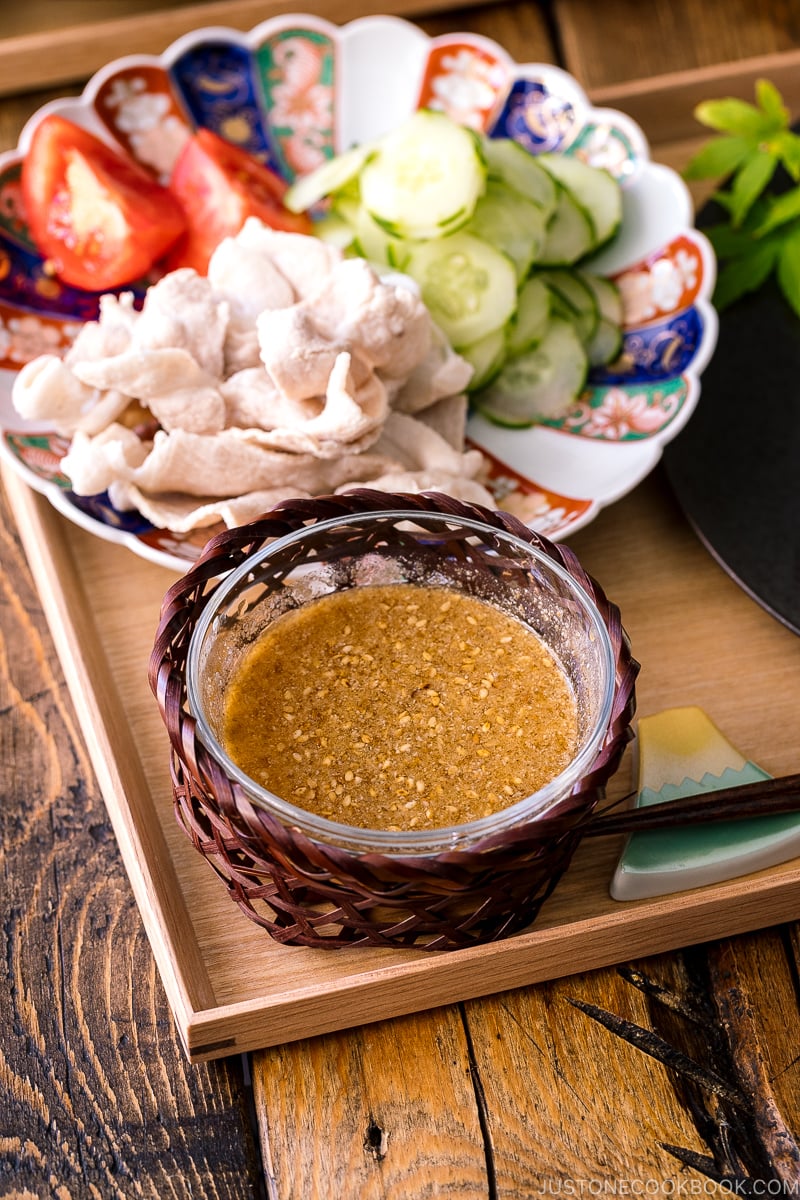
Typically, somen noodles are dipped into Tsuyu (つゆ) or sometimes called Mentsuyu (麺つゆ). It’s a dashi and soy sauce-based noodle soup base to make hot noodle soup or noodle dipping sauce.
For this recipe, I wanted to make it a bit more savory so I’ve added my favorite Barley Miso from Hikari Miso and a spoonful of ground sesame seeds to lend more character.
My Favorite Barley Miso from Hikari Miso

This organic barley miso (mugi miso) from Hikari Miso has a sweet note with a unique aroma of barley koji. This miso is made by adding barley koji, instead of rice koji, into soybeans!
You can get this barley miso at Japanese/Asian grocery stores or online, but in case you can’t find one, use your favorite miso to make the dipping sauce. In fact, it’s nice to change up the miso so you don’t get bored with the same flavor!

Cooking Tips
Somen Noodles
- Always use a big pot of water to cook the noodles.
- Remove all the wrapping of the noodles. Somen noodles cook fast, only 1.5 to 2 minutes! Therefore, you need to act fast. The noodles should be added to the boiling water at the same time!
- After draining water, wash the noodles as if you are washing clothes by kneading or gently massaging. This is the proper way! Somen noodles use oil to achieve its thinness, so we need to make sure to remove the oil.
Pork Shabu Shabu
- Use thinly sliced pork loin from the Japanese/Korean/Chinese market. If you live in the Peninsula (SF Bay Area), I recommend thinly sliced meats (and sashimi-grade fish) from Suruki Market in San Mateo. Amazing tender meat!
- Add sake in boiling water to remove any unpleasant smell from the pork.
- Don’t overcook. As soon as it’s no longer pink, it’s done, just in a few seconds!
Dipping Sauce
- Grind the sesame seeds in a Japanese pestle and mortar for the best texture. If you don’t have one (I highly recommend getting one!), you can use a coffee/spice grinder or a rolling pin.
- Each brand of mentsuyu (noodle soup base) has a different concentration level. More about that in this post.
How to Eat Somen Noodles


Just in case you’ve never had this dish… here’s a quick guide on how to eat the somen noodles.
- Add the pork and cucumber slices to the dipping sauce.
- Pick up a small amount of noodles and dip in the sauce.
- Enjoy the noodles, pork, and cucumber together. And repeat!

Wish to learn more about Japanese cooking? Sign up for our free newsletter to receive cooking tips & recipe updates! And stay in touch with me on Facebook, Pinterest, YouTube, and Instagram.

Pork Shabu Shabu and Cold Somen Noodles with Sesame Miso Sauce
Ingredients
- 1 Japanese or Persian cucumber
- 1 tomato
- 6 oz thinly sliced pork loin
- 1 Tbsp sake (for cooking the pork)
- 7 oz dried somen noodles (4 bundles)
For the Sesame Miso Sauce
- 1 tsp ginger (grated, with juice; from a 1 inch, 2.5 cm knob)
- 1 Tbsp toasted white sesame seeds
- 1 Tbsp miso (I used Hikari Miso Organic Barley Miso)
- 1 tsp sugar
- 1 Tbsp rice vinegar (unseasoned)
- ½ tsp toasted sesame oil
- ¼ cup mentsuyu (concentrated noodle soup base)
- ½–¾ cup water (adjust to your liking as each type/brand of miso has different saltiness)
Instructions
- Gather all the ingredients. Freeze the thinly sliced pork for 10 minutes (so it‘s easy to cut).

To Make the Sesame Miso Sauce
- Grate the ginger (I use a ceramic grater) and measure 1 tsp ginger (grated, with juice).

- Grind 1 Tbsp toasted white sesame seeds in Japanese pestle and mortar.

- In a small bowl, add 1 tsp sugar and 1 Tbsp miso and whisk well to combine.

- Add 1 Tbsp rice vinegar (unseasoned) and ½ tsp toasted sesame oil and mix.

- Add the ground sesame seeds, grated ginger, and ¼ cup mentsuyu (concentrated noodle soup base).

- Add ½–¾ cup water and whisk all together. Chill the sauce in the refrigerator until ready to serve.

To Prepare the Ingredients
- Peel the skin of 1 Japanese or Persian cucumber in a striped pattern. Cut the cucumber into thin slices.

- Cut 1 tomato into wedges.

To Cook the Pork Shabu Shabu
- Cut the half-frozen 6 oz thinly sliced pork loin into smaller pieces; I cut the meat into thirds. Bring a medium pot of water to a boil. Once boiling, add 1 Tbsp sake.

- Cook the thinly sliced pork in 3 batches until no longer pink. Make sure each slice is separated (especially if you freeze for 10 minutes) and do not overcook as the pork will get tough.

- Once the pork is cooked, remove it from the pot and put it in an ice bath to chill. When the pork is chilled, transfer to individual serving plates along with the cucumber slices and tomatoes.

To Cook the Somen Noodles
- Bring a large pot of water to a boil. Remove all the wrappings from 7 oz dried somen noodles first as all the somen should go into the boiling water at the same time.

- Cook the somen noodles for 1½–2 minutes (my favorite Ibonoito brand requires 1½ minutes). Mix the noodles occasionally, making sure they are not stuck on the bottom or the sides of the pot.

- Drain the noodles into a sieve and run cold water over them.

- Once noodles are cold enough to handle, wash them with your hands as if you are washing your clothes. Knead and massage the noodles to get rid of the oil. When you finish, drain well.

To Serve
- Serve the noodles on individual plates and put the sauce in small individual dipping bowls or cups.

- Dip the pork shabu shabu, cucumber, and noodles in the sauce to enjoy!

To Store
- You can keep the leftovers in an airtight container and store in the refrigerator for 2–3 days. However, I do not recommend keeping the noodles as they stick to each other. Make a fresh batch of noodles before you eat. You can use leftover (stuck) noodles in miso soup or make a salad with it (dressing will loosen the noodles).


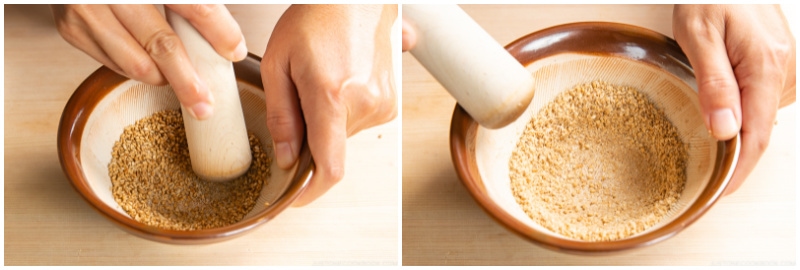



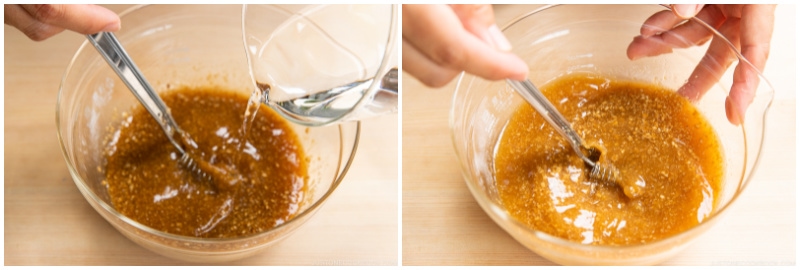




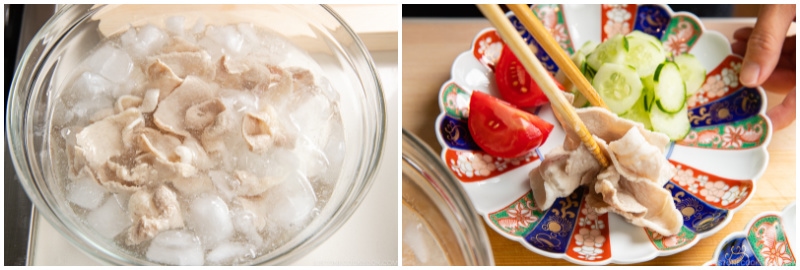
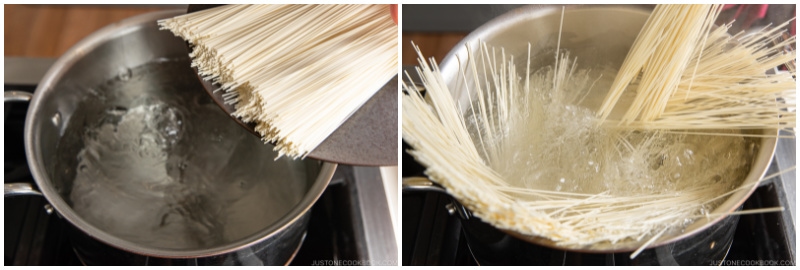
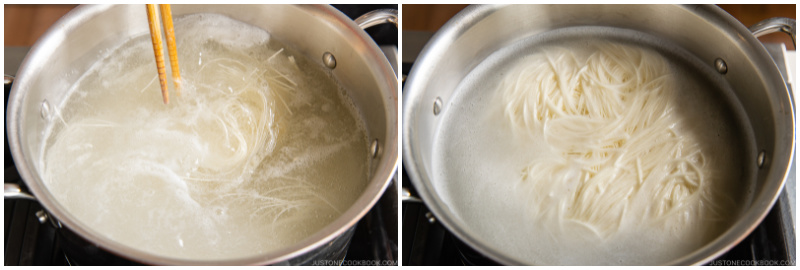













This was absolutely delicious! Thank you
Hi Carrie! Thank you very much for trying Nami’s recipe and for your kind feedback!
We are so happy to hear you enjoyed this dish!☺️
Hi Namiko,
I just made this for dinner with beef slices, komatsuna, and soba. It was really tasty and easy to prepare! (Though I only used 2/3 of the required amount of mentsuyu, and found it already a bit salty for me…😂)
Thank you for the amazing recipe!
Hi Angela! Thank you very much for trying Nami’s recipe and sharing your cooking experience with us!
This dish is a dipping sauce with noodles, which Nami adjusted sauce slightly stronger and saltier. Usually, we dip lightly and enjoy the noodle.
If the sauce is salty to your taste, we recommend diluting it with water.
We hope this helps for your next try!🙂
sounds interesting and tasty, but I don’t quite understand why the ingredients you call for are not all together in a bowl for easier eating like a summer cold soup would be. Also don’t get why you show you are peeling quite a large cucumber that’s similar to a long English cucumber, but your recipe clearly states use small Persian cucumbers which are much smaller and much thinner.
Hi Jocelyn! Thanks for your comment. You’re free to serve however you like it, but in Japan, there are several ways to serve/eat somen. If you are going to serve this dish with the sauce already poured onto the noodle, I highly recommend diluting the sauce more. This is a dipping sauce, which I adjusted to make it slightly stronger. If you get to try this dish twice, with either dipping sauce or pour-over noodles, you will notice it’s kind of different… Like regular ramen and tsukemen… we enjoy dipping plain noodles into a saltier dipping sauce. 🙂
Now about the cucumber. It’s funny you mentioned the size of this cucumber. I was surprised to see this long Japanese cucumber in store too. Usually not this long. 😂 But that’s what I had on this photo shooting day and I did not use all of the cucumber slices. The reason why we use Persian or Japanese cucumbers in many of Japanese recipes is that the seeds in the middle are less (and less moisture) compared to English cucumbers and even so with American cucumbers. If you plan to cut the cucumber into julienned strips, it’s much easier to do so. If you (or anyone) can’t find Persian/Japanese cucumber, my next choice would be English cucumber. If there are lots of seeds, I may scoop out the seeds with a spoon too. Not for this recipe, but in general, that’s what I would do when you see Persian/Japanese cucumber in my recipe and you can’t find it locally.
Hope this helps!🤗